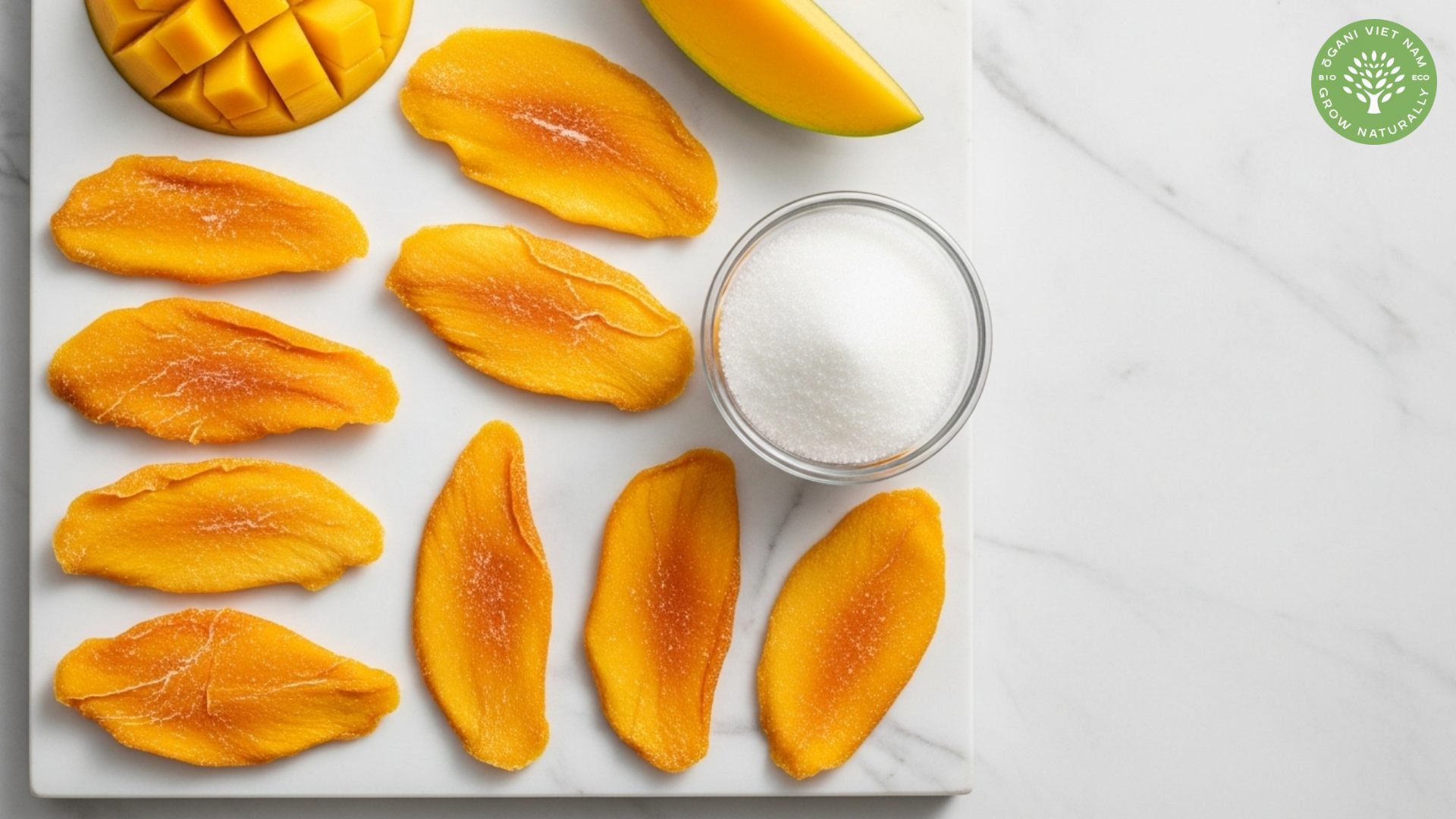When you pick up a bag of dried mango, you’re looking at a snack that contains between 20-30 grams of sugar per serving—roughly equivalent to 5-7 teaspoons of sugar—alongside concentrated vitamins and minerals. At Ogani Vn, we believe you deserve to know exactly what’s in your dried fruit, because that chewy, golden slice isn’t just concentrated mango flavor—it’s concentrated everything, including **sugar in dried mango** and vitamins in dried mango that can surprise health-conscious snackers. While the vitamins provide real nutritional value, the sugar content is what often catches people off guard.
Natural vs added sugar in dried mango explained
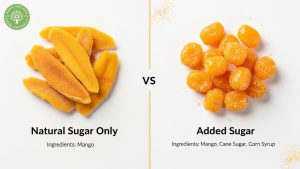
Here’s something most people don’t realize until they flip that package over: not all sugar in your dried mango comes from the mango itself. Fresh mango naturally contains about 14 grams of sugar per 100 grams of fruit. But when you dry it? The water evaporates, the fruit shrinks, and suddenly that same 100 grams is packing 66 grams of sugar or more—nearly five times the concentration.
But wait, it gets trickier. Many commercial brands add extra sweeteners on top of that already-concentrated natural sugar. You’ll see phrases like “lightly sweetened with cane sugar” or spot ingredients like corn syrup, glucose syrup, or rice syrup hiding in the fine print. At Ogani Vn, we’ve tested dozens of brands, and here’s what we found: products labeled “sweetened” or “candied” typically contain 40-50% added sugars beyond what nature provided.
The naturally occurring fructose in mango isn’t inherently bad—your body processes it alongside the fruit’s fiber, vitamins, and beneficial compounds. Added sugars? That’s where things get dicey for your blood glucose levels and daily sugar intake limits. The American Heart Association recommends no more than 25 grams of added sugar daily for women and 36 grams for men. One serving of sweetened dried mango can blow through half that limit before lunch.
How much sugar in dried mango per serving
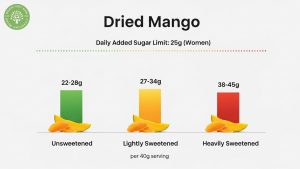
Let’s break down the numbers you’ll see on different types of dried mango, because the variation is wild:
Unsweetened, organic dried mango typically contains 22-28 grams of total sugar per 40-gram serving (about 1/4 cup), with zero added sugars. This is purely the concentrated natural fructose from the fresh fruit.
Lightly sweetened dried mango ranges from 27-34 grams total sugar per serving, with 8-15 grams coming from added sweeteners like cane sugar or fruit juice concentrates.
Candied or heavily sweetened varieties can skyrocket to 38-45 grams per serving, with sometimes more added sugar than natural sugar—essentially turning your “healthy snack” into candy that happens to contain fruit.
For perspective, a fresh mango cup (165 grams) gives you about 22 grams of sugar alongside 3 grams of fiber and 99% of your daily vitamin C. That same nutritional content, dried down to 40 grams, loses most of its vitamin C through heat processing but keeps all the sugar. You’re trading volume and water content for concentrated calories and sweetness.
The serving size game also tricks people. Many packages list nutrition for 28 grams (1 ounce), but who actually weighs their snacks? Most people mindlessly eat 50-80 grams in one sitting—that’s potentially 60+ grams of sugar in dried mango before they realize they’ve demolished half the bag.
Sugar in dried mango: health effects you should know
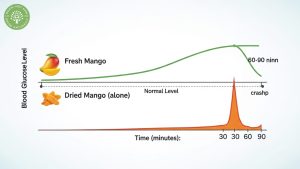
I’ll be honest with you—dried mango isn’t the villain some wellness influencers make it out to be, but it’s not a free pass either. The sugar in dried mango affects your body differently than fresh fruit, and understanding this helps you make smarter choices.
When you eat fresh mango, the high water and fiber content slows down sugar absorption. Your blood glucose rises gradually, your pancreas releases insulin at a manageable pace, and you feel satisfied. Dried mango, stripped of water and much of its fiber, hits your bloodstream faster. One study from the National Center for Biotechnology Information found that while dried mango consumption raised blood glucose levels, it was still significantly lower than white bread—so context matters.
For people managing diabetes or pre-diabetes, timing and portion control become critical. Having 3-4 pieces (about 20 grams) of unsweetened dried mango with nuts or cheese can balance the sugar impact. Eating half a bag while binge-watching Netflix? That’s a glucose roller coaster followed by an energy crash.
The satiety factor is real. Research comparing fresh versus dried mango consumption showed that people felt fuller and more satisfied after eating fresh mango, even with the same calorie content. Dried mango’s concentrated nature makes it easy to overconsume—your brain doesn’t register fullness the same way when water isn’t taking up space in your stomach.
But here’s what the fear-mongering articles won’t tell you: dried mango also concentrates beneficial compounds. You’re getting concentrated beta-carotene, concentrated antioxidants like mangiferin, and concentrated digestive enzymes. A 40-gram serving still provides vitamin A, some B vitamins, and minerals like potassium and magnesium. The key is respecting the portion size and choosing wisely.
Choosing low sugar in dried mango options
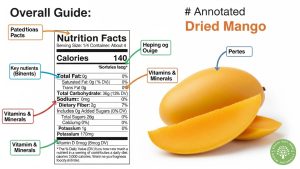
At Ogani Vn, we guide customers through label-reading like we’re decoding a secret language—because honestly, that’s what food packaging has become. Here’s your practical roadmap:
Look for “unsweetened” or “no sugar added” on the front label. This should be your default starting point. Check the ingredient list—it should say “mango” and maybe “citric acid” (for preservation). That’s it. If you see cane sugar, glucose syrup, fruit juice concentrate, or rice syrup listed, you’re getting added sweeteners.
Check the “Added Sugars” line on the Nutrition Facts panel. Since 2020, US labels must distinguish between total sugars and added sugars. Aim for 0 grams added sugars. If the package shows 26 grams total sugars but 0 grams added sugars, you’re looking at pure fruit concentration—that’s acceptable.
Consider sulfur dioxide or sulfite preservation. Some dried mangoes use sulfites to maintain that bright orange color and prevent browning. While FDA-approved and safe for most people, about 1% of the population has sulfite sensitivity. If you see “unsulfured” on organic varieties, the trade-off is a browner, less vibrant color but cleaner processing.
Texture tells a story. Softer, pliable dried mango often contains more residual moisture and sometimes added glycerin or sugar to maintain that candy-like chew. Firmer, slightly leathery pieces typically indicate less processing and no added humectants.
For weight management, portion out 20-30 grams (about 4-6 pieces) into small containers at the start of the week. This pre-planning removes the temptation to overeat directly from the bag. Pair with 10-12 almonds or a tablespoon of nut butter to add protein and healthy fats that slow sugar absorption.
If you’re athletic or highly active, dried mango actually makes an excellent pre-workout or during-workout fuel. That concentrated glucose becomes beneficial when your muscles need quick energy. Time it 30-45 minutes before exercise, and your body will use those sugars for performance rather than storage.
Managing sugar in dried mango consumption daily
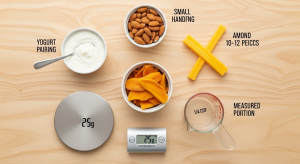
This is where theory meets real life. You want the tropical sweetness, the chewy satisfaction, the convenience—but you also want to avoid the sugar crash and guilt. We’ve collected strategies from nutritionists, diabetic clients, and honestly, our own trial and error.
The protein pairing method: Never eat dried mango alone. Always combine with a protein or fat source. Greek yogurt with 5-6 dried mango pieces and a sprinkle of chia seeds creates a balanced snack where the protein slows digestion. String cheese and 4 pieces of dried mango gives you that sweet-savory contrast while moderating blood sugar impact.
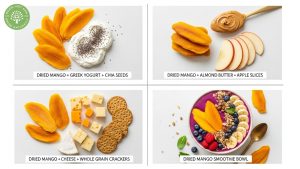
The smoothie dilution trick: Blend 20 grams of dried mango (pre-soaked in water for 10 minutes) with unsweetened almond milk, spinach, protein powder, and ice. You get all the mango flavor distributed throughout 12-16 ounces of beverage, making portion control automatic.
The salad topper approach: Dice 2-3 pieces of dried mango into small bits and scatter over a large salad with mixed greens, grilled chicken, avocado, and olive oil dressing. The tiny amount provides flavor bursts throughout the meal without overwhelming sugar content.
The baker’s substitution: Use finely chopped unsweetened dried mango in place of added sugar in oatmeal, homemade granola, or whole grain muffins. The natural fruit sugars replace refined sugar while adding fiber and nutrients that white sugar lacks.
At Ogani Vn, we’re seeing customers shift toward making their own dried mango at home using dehydrators or low-temperature ovens. Fresh organic mangoes, sliced thin and dried at 135°F for 8-12 hours, give you complete control over the process. No added anything—just pure fruit. The initial investment in a dehydrator pays off within months if you’re a regular dried fruit consumer.
Frequently Asked Questions
Is dried mango healthier than fresh mango?
Fresh mango wins on most nutritional fronts—higher water content, more vitamin C retention, better satiety, and lower calorie density. Dried mango offers convenience, concentrated antioxidants, and longer shelf life. Neither is “bad,” but fresh is generally the better everyday choice while dried works for travel, hiking, or when fresh isn’t available.
Can diabetics eat dried mango?
Yes, in controlled portions. Stick to unsweetened varieties, limit to 15-20 grams (about 15 grams of carbs), and always pair with protein or fat. Monitor your individual blood glucose response, as everyone metabolizes fruit sugars differently. Timing matters too—dried mango after a balanced meal impacts blood sugar less than eating it alone on an empty stomach.
How many pieces of dried mango can I eat per day?
For most healthy adults, 30-40 grams (6-8 medium pieces) of unsweetened dried mango fits within a balanced diet. This provides roughly 100-120 calories and 20-25 grams of natural sugars. If you’re managing weight or blood sugar, reduce to 20 grams (4-5 pieces) and don’t make it a daily habit—2-3 times per week is more sustainable.
Does organic dried mango have less sugar?
Organic certification refers to farming practices, not sugar content. Organic unsweetened dried mango has the same natural sugar as conventional unsweetened varieties—both are simply concentrated fresh fruit. The advantage of organic is avoiding pesticide residues and often skipping sulfite preservatives, but it doesn’t reduce the inherent fruit sugars.
What’s the difference between sugar content in Thai vs Philippine dried mango?
Variety and ripeness matter more than country of origin. Thai mango varieties like Nam Dok Mai tend to be very sweet when fresh (15-17% sugar), so their dried versions are intensely sugary. Philippine Carabao mangoes are similarly sweet. The processing method—whether sugar is added and how much moisture is removed—makes the bigger difference than the source country.
Making smarter choices with your dried mango
The sugar in dried mango isn’t something to fear, but it demands respect and awareness. That 40-gram serving contains the sugar equivalent of 2-3 fresh fruits compressed into a handful of chewy slices—delicious, portable, and nutritious, but also calorically dense and easy to overeat.
At Ogani Vn, we stock carefully selected unsweetened, organic dried mango options that give you the pure fruit experience without the added sugar trap. We believe in transparent labeling, honest portion guidance, and treating dried fruit as the concentrated whole food it is—not candy, not a superfood cure-all, but a valuable part of a balanced diet when consumed mindfully.
Ready to upgrade your dried mango game? Browse our selection of premium unsweetened varieties, check out our portion-controlled snack packs designed for busy lifestyles, or contact our nutrition team for personalized recommendations based on your health goals. Because the right dried mango, enjoyed the right way, absolutely deserves a place in your pantry.
Read more:
- Dried Mango Is It Good For You: Complete Health Guide 2025
- Best Dried Mango No Sugar Added: Premium Quality Guide
- Calories In Dried Mango No Sugar Added: Complete Nutrition Guide
- Are Dried Mangoes Good For You? The Complete Health Guide
- Sugar In Dried Mango: What You Need To Know


